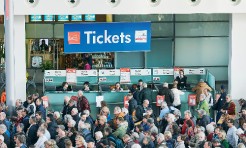Aktuelle Ausgabe
-
23.04.2024 Industry leaders gather in Kigali for the UFI Middle East & Africa Conference
The UFI Middle East & Africa Conference brought together industry leaders, professionals, and stakeholders in Kigali, Rwanda, from 15-17 April. Hosted by the Rwanda Convention Bureau at the Kigali Convention Centre.
-
17.04.2024 Exhibition World Bahrain to Host 2nd Edition of Ghedex Bahrain 2024
Exhibition World Bahrain (EWB) will be hosting the 2nd edition of the Global Higher Education Exhibition “Ghedex Bahrain” on 21-22 April 2024.
-
12.04.2024 Hong Kong: Twin lighting fairs welcomed some 16,000 buyers
Organised by the Hong Kong Trade Development Council (HKTDC), the inaugural Smart Lighting Expo and 15th Hong Kong International Lighting Fair (Spring Edition) (Spring Lighting Fair) concluded successfully.
-
09.04.2024 Finland’s largest LED wall within a conference facility at Helsinki Expo
The Helsinki Expo and Convention Centre will undergo a significant renovation in the fall of 2024. The largest facility in the Conference Centre, hall 101, will be equipped with a new LED wall.
-
03.04.2024 NürnbergMesse celebrates its 50th birthday
NürnbergMesse is celebrating its 50th anniversary – and the City of Nuremberg is celebrating along with it.
-
28.03.2024 AMR 2024 concludes with strong results
The Auto Maintenance and Repair Expo (AMR) concluded on 23 March 2024 at the National Convention and Exhibition Center (Tianjin) with strong results in terms of the exhibition area, and number of exhibitors (1.061) and visitors (45.616 visits).
-
22.03.2024 ExpoTalent supports new business initiatives
Expotalent is a foundation initiated by three experienced professionals in the expo-events industry: Gert Jan van den Nieuwenhoff (Ahoy), Ids Boersma (RAI), and Ton Otten (Jaarbeurs).
-
20.03.2024 Exhibition World Bahrain hosts 1st Media Ghabga
Exhibition World Bahrain (EWB), the award-winning World’s Leading New Exhibition and Convention Centre for the year 2023, hosted its first Ramadan Ghabga for members of the media on Tuesday, March 19, 2024.
-
15.03.2024 UFI Asia-Pacific Conference unites exhibition industry leaders in Macau
Close to 300 delegates from 20 countries and regions attended the UFI Asia-Pacific Conference in Macau. The annual event was held at The Parisian Macao and hosted by the Macau Fair & Trade Association.
-
11.03.2024 Thailand affirms commitment to green future as host of Expo 2029
The International Association of Horticultural Producers (AIPH) has approved the rights for Thailand, a registered candidate, to host the 2029 International Horticultural Expo or “Korat Expo 2029.”
-
07.03.2024 AIPH International Horticultural Expos Conference in Doha
The International Association of Horticultural Producers (AIPH) is a global organisation uniting thousands of growers of flowers and ornamental plants. It is the approving body of International Horticultural Expos, such as Expo Doha Qatar 2023.
-
04.03.2024 ITB 2024: Switch Asia to Green seminar
Sustainability is more important than ever for European tourists, and Asian destinations are increasingly harnessing this potential.
-
28.02.2024 ADIPEC to take place in November 2024 in Abu Dhabi
ADIPEC will be held in Abu Dhabi on 4-7 November 2024, advancing tangible action across the entire energy value chain, accelerating decarbonisation and advancing the global energy transformation.
-
23.02.2024 AsiaWorld-Expo signs multi-year Diamond Sponsorship Agreement with UFI
UFI, the global association of the exhibition industry, and AsiaWorld-Expo have signed a multi-year Diamond Sponsorship Agreement, underlining AsiaWorld-Expo’s commitment to the ongoing development of the exhibition industry.
-
22.02.2024 IMEX Frankfurt responds with intention to the industry’s new needs
With a global range of exhibitors, learning sessions that dig into today’s most pertinent issues and opportunities to build new connections, IMEX Frankfurt 2024 is set to be a show with impact.
-
20.02.2024 Farnborough International invests in the brand behind The British Motor Show
Farnborough Internation has purchased a 48 per cent ownership of Automotion Events, the company behind The British Motor Show, to support the brand in growing its automotive portfolio.
-
14.02.2024 MyCEB enhances Malaysia’s business industry through regional idea exchange
Malaysia Convention & Exhibition Bureau (MyCEB) has made a significant stride in its commitment to elevate the nation’s business events industry.
-
09.02.2024 AUMA: Augsburg and Freiburg the latest to become new members
Augsburger Schwabenhallen Messe- und Veranstaltungsgesellschaft and Freiburg Wirtschaft Touristik und Messe are the latest new members of AUMA – the association of the German trade fair industry.
-
06.02.2024 UFI Global Barometer indicates that the exhibition industry will grow to record levels in 2024
UFI, the global association of the exhibition industry, has released the latest 32nd edition of its flagship Global Exhibition Barometer research which takes the pulse of the industry.
-
02.02.2024 Belgian manufacturing company beMatrix wins award for best stand design
Last night, beMatrix won the award for 'Best Stand Design' in the category of stands from 30 to 69 square metres.
How to keep our Rheingold
14.10.2021
A discussion paper written by Ton Otten, Director International, Jaarbeurs VNU

In 2019 I
read an article from the McKinsey Global Institute about Europe’s innovation challenge
and the need to change the rules of the game [i].
The learnings I took from this article and the post-COVID challenges for the
exhibition industry inspired me to make a bicycle trip this summer from
Switzerland to the Netherlands alongside the borders of the river Rhine. This
area is one of Europe’s most important economic regions and the home ground of numerous
leading exhibition companies. The result of the trip is this discussion paper, which
suggests undiscovered paths to strengthen our competitive edge in the digital
field. Not by trying to play catch-up while hindered by a one-dimensional view
on data, fragmentation and lack of scale, but by changing the game to build on
our strengths.
Collaboration the main success driver
Europe has a history of collaboration across borders and connecting clusters of successful industries. One of the backbones of the European economy is the river Rhine, which flows through the most highly-developed industrial areas of Europe. The geographical location and natural conditions made the development of one of Europe’s most important economic regions possible. In 2019, the population of the Rhine corridor[ii], 12.1 % of the EC and Switzerland, contributed for 17.5 % of the GDP.[iii]
Small, medium-sized and big international companies shaped the Rhine economy, facilitated by governments, institutions, universities, and cross-border business networks to stimulate innovation, partnerships, entrepreneurship, and trade. Collaboration is one of the main success drivers of the Rhine economy, and investors, corporates, and SMEs were always aware of the fact that they needed to share expertise and work as partners to realize the region’s full economic potential. So far, the exhibition organizers were acting in contrast and underestimated the added value of ‘Rhine’ principles as a strategic asset!
The pink elephant in the room
The Rhine river corridor, including the tributaries, is the home ground of Europe’s large-scaled exhibition centers, with 6 out of the 11 venues exploiting more than 100,000 sqm and reported a Euro 2.4 billion revenue in the pre-COVID year 2019. Frankfurt, Cologne and Dusseldorf are ahead of the pack, contributing 65 % of the revenue in 2019, and belonging to the five biggest venues in Europe. The revenue growth of the Rhine corridor exhibition centers was during the timeframe 2010 to 2019 3.5 % per annum, which was 30 % above the national GDP growth of 2.7 %. Despite this good performance, the pink elephant has been in the room a long time! The second half of past decade, 2015-2019, the economy accelerated, and the national GDP grew with 3.4 % per annum. At the same time the exhibition operators in the Rhine corridor were losing ground. The revenue was still growing but ended on 3.6 %, which was only 8 % above GDP level!
During the
past decades most of the venues expanded their business successfully, managed
to recover from the financial crisis and outperformed in 2019. The revenue growth
was generally the result of the increasing volume of their cash-cows,
geo-cloning of brands into new geographical areas and M&A activities. Like
the automobile industry the ‘bigger=better’ principle dominated most of the
decisions about the allocation of talent, resources, budgets, and other assets,
mainly to support the cash-cows. Of course, it was not only tweaking the
business, but lots of new product launches of the past decade are already
forgotten and those who are still battling to move to the next better quadrant the
BCG matrix are not the game-changers we need.
Digitalization the game-changer
Product
innovation is more than the replacement of a brochure by a cool looking website
and digitalization is more than the automation of daily routines. During the
century of mechanization and automation businesses big industries were focused
on volume and efficiency and the value-chains were dominated by conglomerates
and shareholders principles. The historical barriers for innovative start-ups disappeared
when we entered the digitalization area, the moment that capital was nearly for
free and investors were looking for new ways to make a good return on their
money.
Digitalization
has emerged as a game-changer, like the automobile industry faced when Tesla
proved that software is the motor of the value chain instead of the car
manufacturing. From a customer perspective, the product quality and
functionality at the moment of buying is going to be less dominant. But more
important are going to be the software and the infrastructure to receive
continuously, in a high frequency, new services and therefore new features.
Services and features which are based on the end-user data, collected on a
daily and global base.
Digitalization as the enabler for a continuous up-stream of data and down-stream of services sounds like a perfect match to accelerate the ecosystem and to maximize added value. For some tech-companies’ already reality but for most SMEs, including the exhibition operators who were never really at the forefront of technology, a dream to work on. Tech companies continue to push their business models into more industries to leverage their network scale to expand into new technologies such as artificial intelligence. “Data access is as critical to ensure that new ecosystems can thrive. In fact, the value of a network is increasing at the square of its size; finding ways to achieve more access to data to boost size thus has a disproportionately large effect” (McKinsey, October 2019).
Common interests
Exhibitors understand the value of sharing of customers with their competitors because it is an effective and less costly method to get in touch with existing and new buyers. You must give something to gain more! So far discussions about data in our industry were dominated by the point of view that we shouldn’t share our data, which is in contrast with the idea we are selling to our customers! It’s interesting to see that collaboration principle is out of scope when we are talking about digitalization and data, one of the most strategic aspects for the future of our business. This subject needs a broader and more deeper discussion, supported by an analysis of what we should arrange and organize in common, to take advantage of GDP growth and gain leverage.
The exhibition industry has the ability to scale digital innovation, but we need to orientate ourselves on examples that are already working instead of walking the learning curve from scratch. “Examples set by the European Automotive and Telecoms Alliance, which includes telecom operators, vendors, car and truck manufacturers, and suppliers, may be only the beginning, as competitors in the automobile industry combine their research efforts and service offerings to achieve more scale in customer and data access. Such efforts in other sectors could enable small and medium-sized organizers, entrepreneurial companies and attract start-ups to pilot innovation at a larger scale within our supply chains through platforms to play a key role in generating radical innovation” (McKinsey, October 2019).
The roadmap for the digitalization
Denying our common interest, in the area we are facing, is maybe one of the biggest threats to put the exhibition industry at a structural disadvantage. To strengthen our competitive edge, not by trying to play catch-up while being hindered by fragmentation and lack of scale, but by changing the game and build on our strengths and jump on glaringly obvious opportunities. We could rethink data and user access to level the playing field for innovative companies vis-à-vis global-scale data platforms and connect data pools. We could aim to enable secure access for innovators to anonymize data pools they do not own and create scale around common standards.
This discussion paper doesn’t want to give an opinion about what’s best for our industry but to push on the awareness button. A team of business leaders supported by a mixture of external experts needs to work on a roadmap for the digital future of our industry.
[i] McKinsey Global Institute: Innovation in Europe, October 2019 ttps://www.mckinsey.com/~/media/mckinsey/featured%20insights/innovation/reviving%20innovation%20in%20europe/mgi-innovation-in-europe-discussion-paper-oct2019-vf.ashx
[ii] The Rhine corridor includes the
regions North-West Switzerland, Baden-Württemberg, Hessen, Rhineland-Pfalz,
Saarland, Nord-Rhein-Westfalen, East Netherland, West Netherland and the following 11
exhibition venues: Zurich, Basel, Freiburg, Karlsruhe, Frankfurt, Cologne, Dusseldorf,
Essen, Utrecht, Amsterdam, and Rotterdam.
[iii] Source Eurostat and Federal Statistical Office Switzerland
Share in Facebook, Twitter or Google+:
TFI - Trade Fairs International - The International Trade Fair Magazine.
© 2006 - 2024 by TFI-Verlagsgesellschaft mbH. All rights reserved. TFI-Verlagsgesellschaft mbH shall accept no responsibility for the contents of external links and other contents.
TFI-Know-how
-
What to do when things go wrong at virtual or in-person events?

In the event world, it’s simply part of life if things don’t work out as planned.
-
How can networking be made to work at online events?

Networking typically happens at real, in-person events. But it’s also possible to do it online; it just works a little differently. There are various options available to organisers.
-
How can exhibitors stand out at trade fairs?

New products and a well-conceived stand design are not the only drivers for a successful presence. Many other factors are also important, but trade fair planners often lose sight of them.
-
How can industry decision-makers be reached online?

Trade fairs and trade fair companies need to constantly further develop, become more agile and flexible and offer services all year round. New, digital offerings are very important here. With its TrustedTargeting technology, Messe München offers its customers access to leading business-to-business decision-makers on the Internet.


